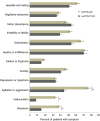Clinicopathologic differences among patients with behavioral variant frontotemporal dementia
- PMID: 23325909
- PMCID: PMC3589292
- DOI: 10.1212/WNL.0b013e3182815547
Clinicopathologic differences among patients with behavioral variant frontotemporal dementia
Abstract
Objective: To characterize the presenting symptoms and signs of patients clinically diagnosed with behavioral variant frontotemporal dementia (bvFTD) and who had different neuropathologic findings on autopsy.
Methods: This study reviewed all patients entered as clinical bvFTD in the National Alzheimer's Coordinating Center's database and who had both clinical and neuropathologic data from 2005 to 2011. Among the 107 patients identified, 95 had unambiguous pathologic findings, including 74 with frontotemporal lobar degeneration (bvFTD-FTLD) and 21 with Alzheimer disease (bvFTD-AD). The patients with bvFTD-FTLD were further subdivided into τ-positive (n = 23) or τ-negative (n = 51) histopathology subgroups. Presenting clinical signs and symptoms were compared between these neuropathologic groups.
Results: The patients with bvFTD-FTLD were significantly more likely than patients with bvFTD-AD to have initially predominant personality changes and poor judgment/decision-making. In contrast, patients with bvFTD-AD were more likely than patients with bvFTD-FTLD to have memory difficulty and delusions/hallucinations and agitation. Within the bvFTD-FTLD group, the τ-positive subgroup had more patients with initial behavioral problems and personality change than the τ-negative subgroup, who, in turn, had more patients with initial cognitive impairment and speech problems.
Conclusion: During life, patients with AD pathology may be misdiagnosed with bvFTD if they have an early age at onset and prominent neuropsychiatric features despite having greater memory difficulties and more intact personality and executive functions than patients with bvFTD-FTLD. Among those with FTLD pathology, patients with τ-positive bvFTD were likely to present with behavior/personality changes. These findings offer clues for antemortem recognition of neuropathologic subtypes of bvFTD.
Figures



Comment in
-
Clinicopathologic differences among patients with behavioral variant frontotemporal dementia.Neurology. 2013 Aug 20;81(8):775. doi: 10.1212/01.wnl.0000433967.51714.84. Neurology. 2013. PMID: 23960196 No abstract available.
Similar articles
-
Clinicopathological correlations in behavioural variant frontotemporal dementia.Brain. 2017 Dec 1;140(12):3329-3345. doi: 10.1093/brain/awx254. Brain. 2017. PMID: 29053860 Free PMC article.
-
Early vs late age at onset frontotemporal dementia and frontotemporal lobar degeneration.Neurology. 2018 Mar 20;90(12):e1047-e1056. doi: 10.1212/WNL.0000000000005163. Epub 2018 Feb 16. Neurology. 2018. PMID: 29453245 Free PMC article.
-
Neuropsychiatric symptom profile differs based on pathology in patients with clinically diagnosed behavioral variant frontotemporal dementia.Dement Geriatr Cogn Disord. 2014;37(1-2):104-12. doi: 10.1159/000354368. Epub 2013 Oct 10. Dement Geriatr Cogn Disord. 2014. PMID: 24135712 Free PMC article.
-
Social Cognition in Behavioral Variant Frontotemporal Dementia and Pathological Subtypes: A Narrative Review.J Alzheimers Dis. 2023;94(1):19-38. doi: 10.3233/JAD-221171. J Alzheimers Dis. 2023. PMID: 37212100 Review.
-
Behavioural variant frontotemporal dementia--defining genetic and pathological subtypes.J Mol Neurosci. 2011 Nov;45(3):583-8. doi: 10.1007/s12031-011-9542-2. Epub 2011 May 11. J Mol Neurosci. 2011. PMID: 21559874 Review.
Cited by
-
Psychotic symptoms in frontotemporal dementia.Curr Neurol Neurosci Rep. 2015 Jul;15(7):46. doi: 10.1007/s11910-015-0567-8. Curr Neurol Neurosci Rep. 2015. PMID: 26008815 Review.
-
Sodium selenate as a therapeutic for tauopathies: A hypothesis paper.Front Aging Neurosci. 2022 Aug 5;14:915460. doi: 10.3389/fnagi.2022.915460. eCollection 2022. Front Aging Neurosci. 2022. PMID: 35992608 Free PMC article.
-
Cerebrospinal Fluid Biomarkers for Alzheimer's Disease in the Era of Disease-Modifying Treatments.Brain Sci. 2021 Sep 23;11(10):1258. doi: 10.3390/brainsci11101258. Brain Sci. 2021. PMID: 34679323 Free PMC article.
-
Positive florbetapir PET amyloid imaging in a subject with frequent cortical neuritic plaques and frontotemporal lobar degeneration with TDP43-positive inclusions.J Alzheimers Dis. 2014;42(3):813-21. doi: 10.3233/JAD-140162. J Alzheimers Dis. 2014. PMID: 24927705 Free PMC article.
-
A scale of socioemotional dysfunction in frontotemporal dementia.Arch Clin Neuropsychol. 2014 Dec;29(8):793-805. doi: 10.1093/arclin/acu050. Epub 2014 Oct 19. Arch Clin Neuropsychol. 2014. PMID: 25331776 Free PMC article.
References
-
- Ratnavalli E, Brayne C, Dawson K, Hodges JR. The prevalence of frontotemporal dementia. Neurology 2002;58:1615–1621 - PubMed
-
- Snowden J, Neary D, Mann D. Frontotemporal lobar degeneration: clinical and pathological relationships. Acta Neuropathol 2007;114:31–38 - PubMed
-
- Neary D, Snowden JS, Gustafson L, et al. Frontotemporal lobar degeneration: a consensus on clinical diagnostic criteria. Neurology 1998;51:1546–1554 - PubMed
-
- Cardarelli R, Kertesz A, Knebl JA. Frontotemporal dementia: a review for primary care physicians. Am Fam Physician 2010;82:1372–1377 - PubMed
Publication types
MeSH terms
Grants and funding
LinkOut - more resources
Full Text Sources
Other Literature Sources
Medical
